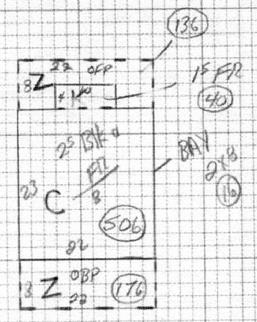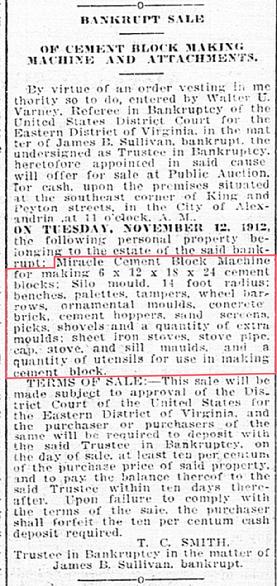The Concrete Houses
Concrete Blocks Come to Alexandria
One of the first in the Alexandria area to jump on the bandwagon was James B Sullivan, who founded a concrete block company around 1907. At that time he was a 35-year immigrant from Canada working as a bookkeeper at a grocery store, living with his wife Elinor and two daughters, along with his in-laws John and Elinor Rowe. It seems likely that his in-laws helped with the financing of his one-man side-line operation turning out concrete blocks, for he called the firm the Rowe Concrete Company. The start-up was slow, but his work accelerated quickly.
n December 1910 he purchased what is now 205 East Alexandria Avefrom J Clinton Smoot. This is a rare house, in that there is no doubt as to who physically built it. The blocks would have come from Sullivan's manual Miracle Concrete Block press, and he probably did all the supervision and much of the labor himself. At the same time he almost certainly provided the concrete block for his daughter's new house at 15 East Alexandria.

An Ill-Advised Partnership
In addition, he seems to have talked his way into a partnership in October 1909 with J Clinton Smoot, who owned 61 lots in the Park Addition development (which lines both sides of East Alexandria Ave), and Frank Slaymaker, the sales agent for Park Addition. They agreed that concrete block houses would be a great venture for Park Addition, and that a prototype should be built on what is now 207 East Alexandria Avenue, with Smoot providing the land, Sullivan the concrete blocks and Slaymaker the marketing and sales. Actual construction of the house was to be funded by a loan of $2,300 signed by all three but secured by a mortgage on the land signed only by Smoot (since he was the land owner).

Once the house was completed and sold the loan would be paid off and the profits split among the three partners. Unfortunately, and perhaps inevitably, there were cost overruns. Smoot refused to commit any more money, leaving Sullivan and Slaymaker with the unpleasant choice between throwing more money into the project or losing their investment.
They chose the former and took out a loan for another $470 in April 1911. The house was completed, but Smoot apparently had had his fill of the effort, and may have seen the writing on the wall foretelling the future of concrete blocks. In any event, in January 1912 he intentionally defaulted on an interest payment on the mortgage and instructed the trustee to go ahead and foreclose on him.
By this point the commercial venture was clearly collapsing. The construction of this house and his own had pushed Sullivan over the edge and he had declared bankruptcy in late 1911. Slaymaker filed a motion in county court and won a brief injunction against the foreclosure sale of the property, arguing that the proceeds would be used solely to repay the mortgage (signed by Smoot), while he wanted the court to sell the land and divide what money derived among the partners. The injunction was short-lived and on February 10th 1912 the 207 E Alexandria house was auctioned off as a foreclosed mortgage.
Shortly after the sale the trustee filed his accounting with the court. He had managed to get $2,550 for the property at auction. Of that, $2,300 went to pay off the principal of the mortgage, $89.14 for missed interest, $17.00 for advertising notices, $10.00 for the auctioneer's fee and $127.50 for the commission on the sale. That yielded a total $2,543.64 in expenses, leaving the princely sum of $6.36 to be split among the partners as surplus. Since Sullivan had already declared bankruptcy, that left Slaymaker holding the bag for the $463 balance of their loan. This was not an inconsiderable sum, as the average American that year earned less than $600.
The Afterword
So two of the partners lost their shirts on the deal. The other one, however, seems to have come out ahead. The winning bidder at the auction was none other than J Clinton's wife Frances (universally known as Frank). In other words, he had taken back a house for $2,550 that had cost at least $2,740 to build, not including the materials provided by the now bankrupt Sullivan.
Frank Slaymaker carried on as a successful realtor, while Sullivan returned to full-time bookkeeping, winding up as the chief clerk of the Alexandria Fertilizer and Chemical Co in 1919, before throwing in the towel and moving out of the area.
Foreword
The introduction of Portland cement to the US in 1872 spurred a revolution in construction. Where stonemasons needed to be highly skilled to chisel, size and fit natural stones into a stable structure, hollow concrete blocks of uniform, optimal size and shape could be built into walls quickly by supervised apprentices.
The St Louis Exposition of 1904 led to an explosion of interest in concrete block construction, with about a half dozen firms offering machines for the local production of such blocks. The Miracle Pressed Stone Company of Minneapolis, for example, offered everything from a 58-pound one-man press that made one 8x8x16 block at a time to an adjustable model that could make blocks up to 20 inches long and 12 inches wide.
The reign of the concrete block was relatively short. For commercial buildings it was replaced by poured concrete surrounding rebar, while for smaller-scale residential uses it was edged out by the lighter and easier to handle cinder block.
All three of the Sullivan houses are still in existence, two in pristine original shape and the third with a nice sympathetic addition. These are at 15 East Alexandria, 205 East Alexandria and 207 East Alexandria.
The original footprint of Sullivan's house at 205 E Alexandria